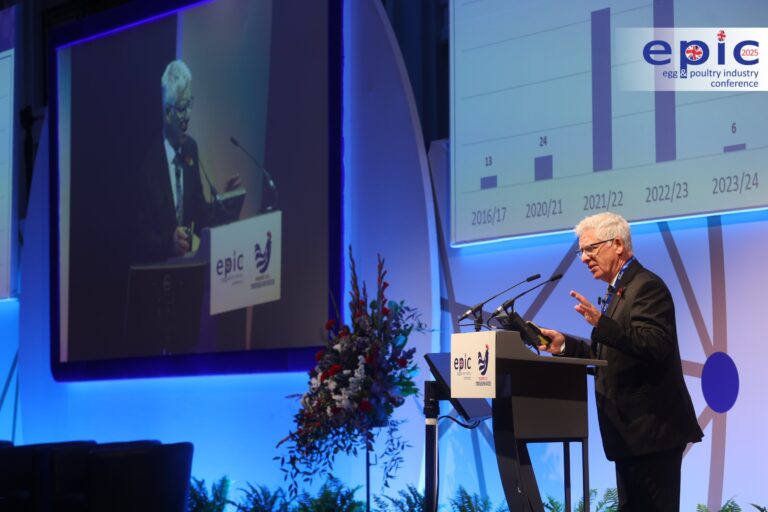At EPIC 2025, the avian influenza expert called for renewed discipline
Stepping in at short notice after a ministerial reshuffle left the government slot vacant, Professor Ian Brown – recently retired from the Animal and Plant Health Agency but now working part time with the Pirbright Institute – delivered a comprehensive overview of the UK’s avian influenza challenge.
He began by setting out the scale of the problem. “I’ve got the task to tell you where we are, where we’re going, and what opportunities we might have from vaccination,” Brown said. “I’m sure none of you in the room are not touched in some way by avian influenza.”
Troubling outlook
The outlook for winter 2025-26, Brown warned, is troubling. “We’re already at a high level of risk. This virus is reaching parts that perhaps ten years ago it didn’t reach. So, no one is immune from being exposed to this disease.”
With cases continuing across Europe, the pattern looks ominously familiar. “The trajectory, the pattern of cases, what is happening on the continent gives us real cause for concern,” he said. “German colleagues told me this is their biggest hit for many years. This is a serious situation we’re facing.”
Biosecurity
Brown’s message on biosecurity was blunt. “A teaspoon of infected faeces would be enough to kill a million turkeys,” he said. “A small piece of organic matter on a boot or piece of clothing, going into a poultry house, is going to set off and trigger an outbreak. Hygiene absolutely has to be spotless.”
But he recognised that years of high alert have left many producers stretched thin.
“Time and competing demands… financial constraints, long hours, not enough financial gain and temporary staff – all of these contribute to risk, non-compliance, cutting corners. Biosecurity fatigue, repetition, stress.”
His advice was clear. “If you haven’t done a risk-level audit, looking at biosecurity on your farms, it would probably be well overdue.”
Dangerous variant
Brown reminded delegates that the virus they face today is not the same as that of a decade ago.
“We are dealing with a virus here that is punching well above its weight. It is the most dangerous H5 virus we’ve ever encountered.”
Vaccination
The question of vaccination dominated the session.
“Vaccination will only work when combined as part of a larger control programme,” Brown said. “It is not a substitute for weak biosecurity. If you vaccinate and then ignore biosecurity, you’ll end up with a big problem.”
He set out the case for considering vaccination despite the challenges.
“We want to protect food security and the livelihood of the rural economy. Improving the health and welfare of our birds – if we have to kill fewer birds, obviously that’s good. We want to make sure we’re a step ahead of the virus. We want to vaccinate today, but we want to vaccinate for tomorrow and the day after.”
Vaccines, he said, “decrease the susceptibility of the bird to becoming infected” and “reduce the amount of virus those birds shed into the environment.” But “vaccinated flocks can become infected,” meaning surveillance will remain essential.
Trade, cost and confidence
“The programme is going to be expensive as it stands,” Brown acknowledged. “44% of the cost of vaccinating is contributed by the surveillance costs.”
EU requirements, he explained, were initially “pretty cautious,” but change is coming.
“You’re looking to change those regulations… to recognise that picking up the dead birds, rather than the 30-day monitoring of healthy birds, could be sufficient. That will be a significant change.”
And on the crucial question of trade, he offered reassurance. “The World Organisation for Animal Health has come out very strongly in the last few years and said vaccination should not be a barrier to safe trade.”
Lessons from France and the Netherlands
Across Europe, Brown said, vaccination pilots are already under way.
“The Dutch have started vaccinating some hens. They’re testing the water, talking to their trading partners, saying, ‘We’re doing this, we can do it effectively, we want to build confidence and trust.’”
“The French have been vaccinating ducks since October 2023. They used two different vaccines and in 2023–24 only had ten poultry outbreaks. There was a beneficial effect for other sectors as well, because the duck industry was a source of virus for other birds.”
He cautioned, however, that the coming winter will be the real test.
“It’ll be very interesting to see how their vaccinated population fares against increased challenge.”
The Road Ahead
“For these programmes to work, we’re going to need all of these tools – good vaccines, good diagnostics, a commitment from the poultry producers, and good data,” Brown said. “We need to show and track the traceability of the entire process.”
He noted that “the global risk is increasing,” and that the industry must take “a much more proactive view” of vaccination as “a tool for threat reduction and mitigation.”
“It won’t be a magic bullet,” he concluded. “It will be painful. There’ll be barriers and challenges. But with concerted global action, these diseases can be controlled.”


